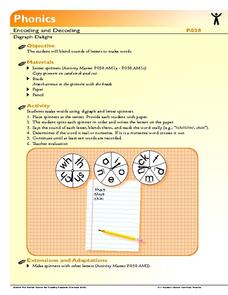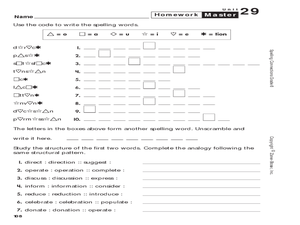Florida Center for Reading Research
Phonics: Encoding and Decoding, Digraph Delight
There are three spinners to use in this phonic activity. Spinner one contains digraphs, spinner two contains vowels, and spinner three contains consonants. Learners spin each spinner, write down the letters they get, blend them to make a...
Curated OER
Phonics: Read and Write Irregularly Spelled Words
Kids practice saying and identifying words that have irregular spellings. They consider the words said, come, and does by breaking them down into how they are commonly pronounced versus how they "should" be pronounced given their spelling.
Curated OER
Using a Dictionary: Root Words
A dictionary is a very helpful tool. Teach your third graders how to locate words, define them, and understand what root words are. They look up 12 words, write their definitions, then determine the root word that helps categorize each...
ABCya
Word BINGO
Practicing sight words is all fun and games with this app! Users hear, read, and spell words off the Dolch Word List. But that's not all! Players also get to create their own avatar, collect BINGO bugs, view their scores, and more within...
University of Texas
Alphabetic Understanding, Phonics, and Spelling
Have your youngsters reading in no time with with collection of literacy activities and lessons. Starting with a basic understanding of the alphabet, this unit progressively builds students' phonemic awareness and ability to decode and...
Florida Center for Reading Research
Word Steps
Blending basic CVC letters to make words is one of the first steps to independent reading. Provided here are several images of stairs and several letters to cut and arrange. The learner rearranges the letters to form CVC patterns, sounds...
Florida Center for Reading Research
Phonics: Encoding and Decoding, Three-In-One
Scholars use the provided pack of alphabet cards to construct basic CVC words, then write down each word they make in one of two columns. Column one is for real words and column two is for nonsense words.
Reading Resource
Pyramid Words
Sometimes it helps struggling readers to see that all words are just letters strung together. Use a pyramid word activity to guide kids through writing out an entire word by adding one letter at a time on the spaces provided.
Curated OER
Wide Mouthed Frog Memory or Wide Mouthed Frog Sight Word Game
How appropriate is playing a game of memory to help children memorize their sight words! Offering fun frog-themed flash cards and instructions for playing two different sight word games, this would make a great addition to the resource...
Curated OER
Spelling Connections: Grade 2: Spelling Words in Code
In this spelling worksheet, students use the code key to decode the ten spelling words. This is a simple letter and number code.
Meadows Center for Preventing Educational Risk, University of Texas at Austin
Lesson 12 - Ed Suffix with Unchanging Base Words
Understanding different verb tenses begins with knowing how to decode words. A lesson plan on the -ed suffix with unchanging base words introduces readers to the past tense. Teachers present the skill with oral reading and spelling...
Curated OER
Spelling Words In Code
In this spelling learning exercise, students use the code to write 27 spelling words. Students must double the final T or L before adding the ending on certain words.
Curated OER
Use The Code to Write Spelling Words
In this spelling worksheet, students use the code key at the top of the page to decipher 20 spelling words. Students write the words on the lines.
Florida Center for Reading Research
Phonics: Encoding and Decoding, Make-A-Word
Little learners place a picture card on a magnetic board, say the name of the object on the card, then sift through alphabet magnets to find and spell the word they said.
Florida Center for Reading Research
Phonics: Encoding and Decoding, A Digraph A Word
Learners view a series of images, then choose digraphs, consonants, and vowels to spell out the object's name on each card.
Florida Center for Reading Research
Phonics: Encoding and Decoding, Vowel Stars
Learners are given a star; each star contains a c_c form in the center and vowels on each point. They use the vowels to fill in the blank between the consonants making a simple CVC word. They write each word they make on a piece of paper.
Florida Center for Reading Research
Phonics: Encoding and Decoding, Letter Cube Blending
Emergent readers use a letter cube to identify, blend, and make words. They roll each of the three-letter cubes, mark down the letters they rolled, then blend the letter sounds together to make a word. They record each word on a...
Curated OER
Word Origins
Understanding a word's etymology can really help with decoding and building vocabulary skills. Readers compare and contrast words of similar origins but with different difficulty levels. They focus on prefixes, suffixes, and affixes....
Meadows Center for Preventing Educational Risk, University of Texas at Austin
Lesson 16 - Adding Vowel Suffixes to CVC and Silent E Base Words
There's a big difference between hoping and hopping. A lesson on adding vowel suffixes discusses when to double a consonant before adding a suffix such as -ed or -ing. Readers practice breaking down words into syllables and creating new...
Curated OER
Sounding Out Words
For this CVC words review worksheet, writers examine six pictures and sound out the words that identify each of them. Spaces are provided to write three letters per picture. You might want to give hints as some of the pictures are harder...
Curated OER
Rhyming Words: The Ut Family
What a great resource! Learners can review words with short vowel sounds, such as bun, bus, and hut using this presentation. The slides are easy to understand and colorful. This would be a quick way to review these words either in a...
Reading Resource
Ways to Practice Words at Home
Looking for more ways to practice writing words? A list of 27 strategies will engage learners of any level. Kids can choose between writing their words in peanut butter, criss-crossing them with words that share common letters, and...
Curated OER
Symbol Code and Spelling Words
In this spelling worksheet, students use a code key with picture symbols to decode ten spelling words. Students decipher each word and print it on the lines.
Curated OER
Decoding the Spelling Words
For this spelling worksheet, students use the key to decode 20 spelling words. Students decipher the words and write them on the lines.

























